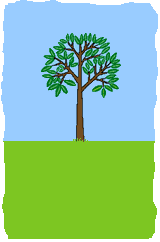 In many countries it has long been the tradition to hold an
annual tree or forest festival. The origin of such celebrations dates back
to antiquity and is in the dawn of religious feeling and awe for what
trees represented. However, Arbor Day, as it is commonly known today, is
of American origin and evolved from conditions peculiar to the Great
Plains. It was first observed in Nebraska in 1872. In many countries it has long been the tradition to hold an
annual tree or forest festival. The origin of such celebrations dates back
to antiquity and is in the dawn of religious feeling and awe for what
trees represented. However, Arbor Day, as it is commonly known today, is
of American origin and evolved from conditions peculiar to the Great
Plains. It was first observed in Nebraska in 1872.
The idea, conceived by J.S. Morton, then a member of the Nebraska State
Board of Agriculture, was one of forest conservation. It was a move to
promote replanting, following deforestation, and to plant up treeless
areas. The idea has spread widely to other lands where it is variously
celebrated as the 'Festival of Trees', 'Greening Week' of Japan, 'The New
Year's Days of Trees' in Israel, 'The Tree-loving Week' of Korea, 'The
Reforestation Week' of Yugoslavia, 'The Students' Afforestation Day' of
Iceland and 'The National Festival of Tree Planting' in India. Arbor Day
in its various forms is now recognised in more than fifty countries.
THE IMPORTANCE OF ARBOR DAY
On Arbor Day, particular attention is drawn to the part trees play in
our lives. It's not just a day to plant trees and then forget the gesture
for another twelve months. Planting a tree one day is no credit to us if,
during the rest of the year, we neglect to care for it and those already
growing. Our thought on Arbor Day should be an expression of enduring
feeling, thought and action and not just one single, isolated flame of
interest.
In schools and other community groups, this day can be celebrated in
many different ways.
·By planting trees or shrubs in school grounds, along neighbouring
streets or in civic parks.
·By 'adopting' a patch of bush, with the
landowner's consent, and caring for it by removal of weeds, rubbish, etc,
by preparing firebreaks and by fencing and making paths to reduce
trampling.
·By presenting a play or mime about trees in the history of
Australia.
·By completing a project about certain types of trees (eg.
jarrah, boab, karri) or a famous tree like the Gloucester Tree near
Pemberton.
·As a class activity or common interest group go on a visit
to a bush area with a spokesperson to explain the characteristics of plant
species and their niche in the natural environment.
·Collect some tree
seeds, germinate them in a classroom, and plant out the seedling.
·Carry out identification of trees in a specific part of your school
or neighbourhood. A tree labelling ceremony could also be arranged.
·Compile a list of everyday objects that are made of wood or
wood-based materials, and find out how the wood was processed, where it
came from and whatever else you can.
Trees and shrubs, whether
native or introduced to WA, provide opportunities for the interest and
study by the whole community, and when we walk around our own
neighbourhood or drive through the countryside, we can appreciate the
importance of such a diversity of plants to the well being of
humanity.
|